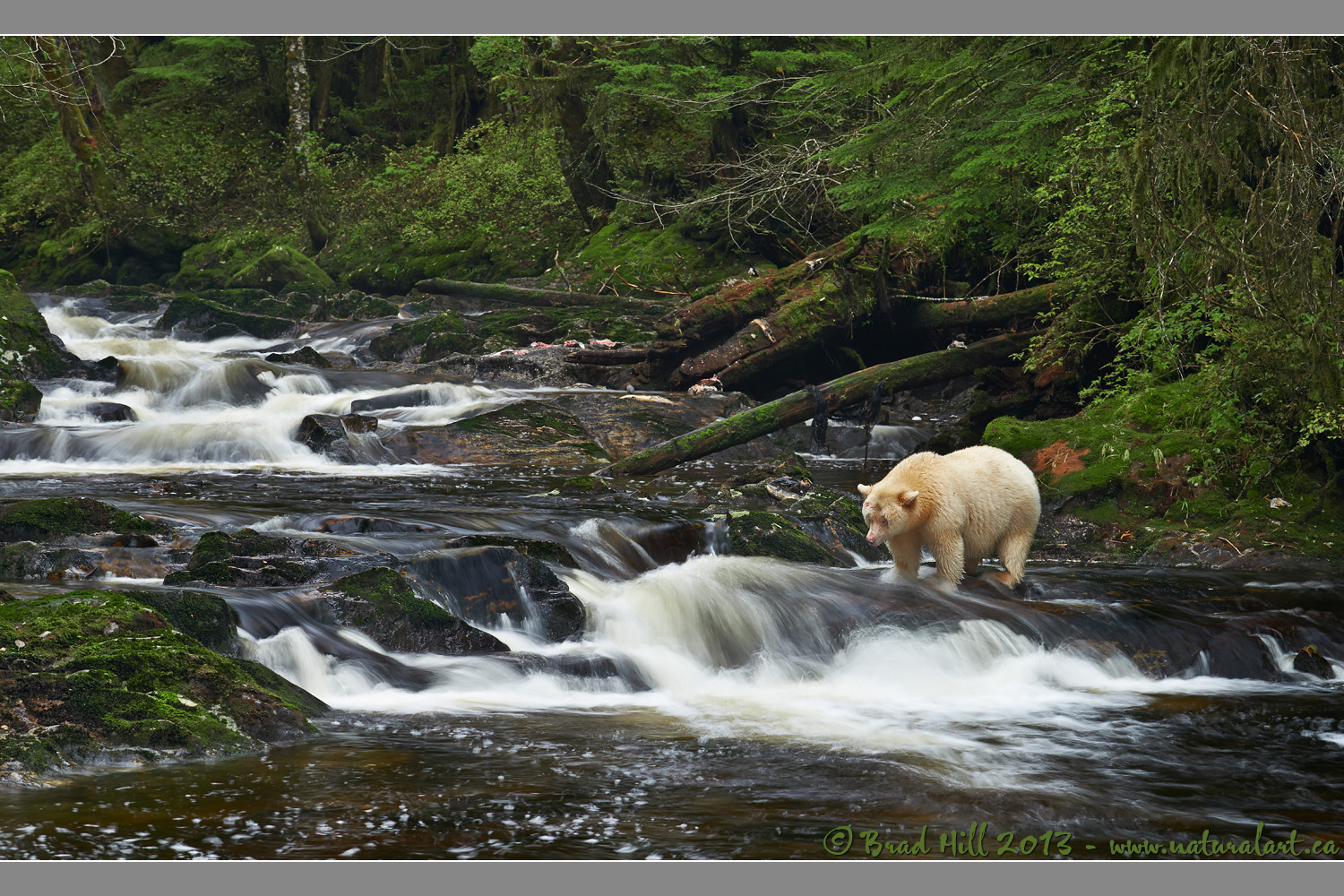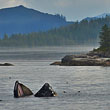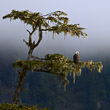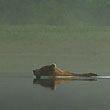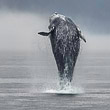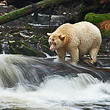Availability: Limited Edition Print - info coming soon!
In the Field
The Great Bear Gauntlet. Gitga'at Traditional Territory, Great Bear Rainforest, BC, Canada. October 3, 2013.
The rare white-phased form of the black bear - the Spirit Bear - has become a symbol of the rarity and uniqueness of a tract of rainforest on the rugged British Columbia coast that is known as the Great Bear Rainforest. There's a lot of forest left in BC, but in all of history there's only been one forest that has - along with all its inhabitants - developed in such a way so that all the conditions necessary to produce the unique life form we know as the Spirit Bear are met. When we look at a Spirit Bear we see something rarer than the bear itself - we see a situation where literally millions of years of evolution have produced a unique outcome - one not repeated anywhere else on planet earth.
Think about it - millions and millions of years of evolutionary trial-and-error involving millions of species - and we see Spirit Bears being produced and found in significant numbers just ONCE, and in only ONE PLACE on earth. How many Spirit Bears are there? About 200-300. A number that is so small that their ability to respond to and react to any change in their environment is severely impaired...
And yet...in this day and age of supposed enlightened thinking...a small, well-heeled group thinking only of making a quick buck from exporting the toxic output of Alberta's tarsands to China have found a way to convince themselves that the risk of running massive tankers through the hazardous waters of the Great Bear Rainforest - and right by the two islands where the vast majority of Spirit Bears are found - is worth it. The only population of Spirit Bears ever found on the planet, and big oil and the existing governments of BC, Alberta, and Canada consider it expendable. Just to line their pockets, to placate their buddies and financial backers, and to keep Alberta sales-tax free. There is only one way to describe it: moral bankruptcy - and political cowardice. It defies logic.
But back to the image. I was presented with this amazing Great Bear Rainforest scene courtesy of representatives of the Gitga'at First Nations of BC - and my thanks are extended to them. Seeing any Spirit Bear is a special and amazing experience; watching one intently fishing in a scene like this - one where only a handful of humans have ever been allowed to enter - is...well...indescribable! Hopefully future generations - and the photographers from future generations - will have the opportunity to witness such a scene for themselves...
For those scratching their head over the title of this image - put yourself in a spawning pink salmon's position - after traveling the open ocean for two years you have to travel up over countless obstacles to get to your natal stream before you can complete your lifecycle. You turn a corner in the stream and you see rapids with only one easily navigable route through it. And, sure enough, there's a white bear there intently watching for any salmon daring enough to pass by him (or, in this case, her). Curses! ;-)
This image was captured with a Nikon D800e and is virtually full-frame - the detail in the full resolution image is quite delectable (and I was REAL lucky the bear managed to stand still for the half second the shutter was open while this image was being captured). I can't post the full 7000 pixel plus version of this image here, but here's a 2400 pixel version that shows at least SOME of the detail of the full-res version:
• The Great Bear Gauntlet: Download 2400 pixel image (JPEG: 2.3 MB)
ADDITIONAL NOTES:
1. This image - in all resolutions - is protected by copyright. I'm fine with personal uses of it (including use as desktop backgrounds or screensavers on your own computer), but unauthorized commercial use of the image is prohibited by law. Thanks in advance for respecting my copyright!
2. Like all wildlife photographs on this website, this image was captured following the strict ethical guidelines described in The Wildlife FIRST! Principles of Photographer Conduct. I encourage all wildlife photographers to always put the welfare of their subjects above the value of their photographs.
3. This image was captured during one of my "Into the Great Bear Rainforest" photo tours during the autumn of 2013. Each year I offer trips into two different parts of the Great Bear Rainforest as well as one to photograph aquatic mammals and oceanscapes near the northern tip of Vancouver Island. And, in selected years, I also offer photo tours to locations to capture other highly sought-after subjects, such as various owl species of the boreal forest and wildlife of Canada's Arctic. Details about these trips can be found on the Photo Tours page of this website.
Behind the Camera
The Great Bear Gauntlet. Gitga'at Traditional Territory, Great Bear Rainforest, BC, Canada. October 3, 2013.
Digital Capture; Compressed RAW (NEF) 14-bit format; ISO 100.
Nikon D800e paired with Nikkor 70-200mm f4 VR lens @ 100mm. Circular polarizer used. Tripod mounted, Live View, cable release. VR OFF.
0.4s @ f10; -1.33 stop exposure compensation from matrix-metered exposure setting.
At the Computer
The Great Bear Gauntlet. Gitga'at Traditional Territory, Great Bear Rainforest, BC, Canada. October 3, 2013.
RAW Conversion to 16-bit TIFF, including first-pass/capture sharpening using Capture One Pro version 7. Three raw variants (different versions of a single raw capture) differing by a total of 0.5 stops in total exposure.
Further digital corrections on resulting 16-bit TIFF files using Adobe's Photoshop CC and Light Craft's LightZone. Photoshop adjustments included compositing (blending) of the three exposure variants, minor selective colour saturation and desaturation, and sharpening for web output. Final tone tweaking performed using tonemapper/re-light tool in LightZone.
Conservation
The Great Bear Gauntlet. Gitga'at Traditional Territory, Great Bear Rainforest, BC, Canada. October 3, 2013.
Ten percent of the revenue generated by this image will be donated to Raincoast*.
Species Status in Canada**: Not currently listed as Threatened or Endangered.
The "Spirit" Bear is a rare genetically-based colour variant of the common Black Bear (Ursus americana). It has been estimated that less than 300 Spirit Bears exist today. Because the Black Bear is not considered under threat as a species, the Spirit Bear suffers from having the same conservation designation (it should be acknowledged that in British Columbia - the jurisdiction of greatest Spirit Bear abundance - hunting of these white-coated bears is not permitted). For reasons that are not fully understood, the Spirit Bear occurs with greater frequency in a relatively small geographic area within The Great Bear Rainforest of the central and northern coast of British Columbia. In this area 10 to 30% of the bears possess white coats. Many of the black-coloured Black Bears in this region carry the gene for white coats, so allowing hunting of ANY Black Bears in this region can reduce the frequency of the gene for white coats. Thus, to protect the Spirit Bear, it is necessary to prohibit the hunting of ALL Black Bears in this region. And, very unfortunately, the globally unique ecosystem that contains the Spirit Bear is under development pressure, especially from the forestry industry. If this unique environment is altered, we may lose the wonderful genetic anomaly known as the Spirit Bear forever.
The region this image was shot in is, at the time of this writing (November 6, 2013), facing a new and potentially catastrophic threat. There is a proposal to bring oil super-tankers through the narrow and treacherous channels of the Great Bear Rainforest. Any mishap - such as the one that sunk the Queen of the North ferry on March 22, 2006 - could result in an oilspill with disastrous consequences.
*The Raincoast Conservation Society (and Foundation) is an effective and efficient organization that has been fighting for protection of this unique habitat. If you are looking for a meaningful way to contribute to the conservation of this amazing ecosystem, Raincoast will provide maximal "bang" for your conservation dollars.
**as determined by COSEWIC: The Committee on the Status of Endangered Wildlife in Canada













